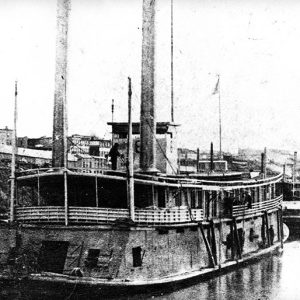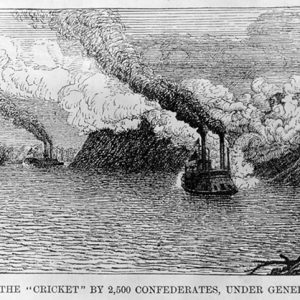calsfoundation@cals.org
USS Cricket
The USS Cricket was a sternwheel steamboat built in 1860 and purchased by the U.S. Navy in 1862 for Civil War service in western waters, including extensive activity in Arkansas rivers.
Cricket No. 2, as the boat was originally named, was constructed in 1860 at California, Pennsylvania, for R. Hamilton of Hanging Rock, Ohio, and John Kyle of Cincinnati, Ohio. The vessel was 151 feet long and 27.7 feet wide. It ran between Pittsburgh, Pennsylvania, and Cincinnati, Ohio, and, during the summer, between Cincinnati and Louisville, Kentucky, under the command of Captain S. B. Hempstead. The Union navy bought the ship on November 18, 1862, at Cairo, Illinois, and converted it to a tinclad gunboat with the addition of one-and-one-quarter-inch armor plating and the installation of six 24-pounder howitzers. It was commissioned the USS Cricket on January 19, 1863, under the command of Acting Master A. R. Langthorne.
The Cricket was stationed on guard duty at Memphis, Tennessee, from February 4 to April 7, 1863, where the main action it saw was the seizure of cotton from the steamboats Delta and Forest Queen on March 15, which was delivered to Cairo. The Cricket was sent to the White River Station where Arkansas’s White River feeds into the Mississippi, patrolling the latter to keep Confederate troops and supplies from crossing to the eastern shore and to challenge Confederate guerrillas and artillery. It fought Confederate batteries above Argyle Landing on May 2 and at Greenville, Mississippi, on May 4.
In August 1863, the USS Cricket, along with the Lexington and Marmora, linked up with Brigadier General John Wynn Davidson’s cavalry division at Clarendon (Monroe County) during the Little Rock Campaign. The three ships sailed up the White River on August 12 in pursuit of Confederate general John Sappington Marmaduke and the steamboats Tom Sugg and Kaskaskia. The Cricket separated from the others and steamed up the Little Red River, capturing the two steamboats at Searcy (White County). As the three vessels—the steamboats having been “armored” with cotton bales—headed back down the Little Red, they were attacked at West Point by Confederates of Brigadier General Joseph O. Shelby’s Iron Brigade. After a sharp engagement, the little flotilla returned to the White River.
The Cricket spent November and December escorting troop transports on the Tennessee River, then transferred to the Red River Station to participate in the Red River Campaign in the spring of 1864. Admiral David Dixon Porter chose the Cricket as his flagship during the disastrous campaign, and as the Union navy fought its way back down the Red River after the army was turned back at Pleasant Hill, Louisiana, the Cricket and several other gunboats were attacked by around 200 Confederate soldiers and four cannons near the mouth of the Cane River. The Cricket was struck thirty-eight times during the attack and lost half its crew, with twenty-five men killed and wounded. Porter employed escaped slaves as a makeshift gun crew to enable the tinclad to escape capture.
The battered Cricket was sent to Mound City, Illinois, for repairs from May 31 to August 13, 1864, after which it returned to White River Station for service until the end of the war. Decommissioned on June 30, 1865, the warship was sold to a private owner on September 25, operating again as Cricket No. 2. Its last owner was Captain William Durbridge of New Orleans, Louisiana, and the vessel was dismantled in 1867.
For additional information:
Christ, Mark K. Civil War Arkansas, 1863: The Battle for a State. Norman: University of Oklahoma Press, 2010.
“Cricket.” Dictionary of American Fighting Ships. Naval History and Heritage Command. https://www.history.navy.mil/research/histories/ship-histories/danfs/c/cricket.html (accessed June 13, 2018).
Joiner, Gary D. Mr. Lincoln’s Brown Water Navy. Lanham, MD: Rowman & Littlefield, 2007.
Pratt, Fletcher. Civil War on Western Waters. New York: Henry Holt and Company, 1956.
Way, Frederick Jr., comp. Way’s Packet Directory. Athens: Ohio University Press, 1994.
Mark K. Christ
Little Rock, Arkansas
 Civil War through Reconstruction, 1861 through 1874
Civil War through Reconstruction, 1861 through 1874 Military
Military USS Cricket
USS Cricket  USS Cricket
USS Cricket  West Point Memorial
West Point Memorial 




Comments
No comments on this entry yet.